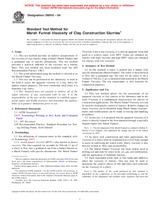Potřebujeme váš souhlas k využití jednotlivých dat, aby se vám mimo jiné mohly ukazovat informace týkající se vašich zájmů. Souhlas udělíte kliknutím na tlačítko „OK“.
ASTM D6910-04
Standard Test Method for Marsh Funnel Viscosity of Clay Construction Slurries
Automaticky přeložený název:
Standardní zkušební metoda pro Marsh Nálevka Viskozita jílové výstavbě kalů
NORMA vydána dne 1.1.2004
Informace o normě:
Označení normy: ASTM D6910-04
Poznámka: NEPLATNÁ
Datum vydání normy: 1.1.2004
Kód zboží: NS-36971
Počet stran: 3
Přibližná hmotnost: 9 g (0.02 liber)
Země: Americká technická norma
Kategorie: Technické normy ASTM
Anotace textu normy ASTM D6910-04 :
Keywords:
bentonite slurry, clay slurry, funnel viscosity, hydraulic barriers, marsh funnel, slurry, viscosity, ICS Number Code 17.060 (Measurement of volume, mass, density, viscosity), 91.100.15 (Mineral materials and products)
Doplňující informace
| Significance and Use | ||||
|
This test method allows for the assessment of an apparent viscosity of clay slurries in the laboratory and in the field. Viscosity is a fundamental characteristic for slurries in construction applications. The Marsh Funnel Viscosity test can be used for field quality control of slurries. Relative changes in slurry viscosity can be identified using Marsh Funnel measurements and modifications can be made to mixing and handling procedures. In this test, it is assumed that the apparent viscosity of a slurry is directly related to the flow duration through a specially shaped funnel (the Marsh Funnel). Note 1—The development of the Marsh Funnel is credited to Hallan N. Marsh of Los Angeles who published the design and use of his funnel viscometer in 1931. In slurry wall construction and other applications, the viscosity of a slurry must be maintained at a level high enough to assist in stabilizing the trench walls. Slurry viscosity is also directly related to filter cake permeability. The Marsh Funnel Viscosity has been widely used in drilling soil and rock for water wells, oil, gas, soil stabilization, and the application of hydraulic barriers. Inert suspended solids such as fine sands and additives affect the viscosity of slurries. This test may be used to determine the relative effects of this and other such materials on the viscosity of a slurry. Note 2—The quality of the result produced by this standard is dependent on the competence of the personnel performing it, and the suitability of the equipment and facilities used. Agencies that meet the criteria of Practice D 3740 are generally considered capable of competent and objective testing, sampling/inspection/etc. Users of this standard are cautioned that compliance with Practice D 3740 does not in itself assure reliable results. Reliable results depend on many factors; Practice D 3740 provides a means of evaluating some of those factors. |
||||
| 1. Scope | ||||
|
1.1 This test method provides an indirect measurement of the viscosity of clay slurries using a funnel (Marsh Funnel) and a graduated cup of specific dimensions. This test method provides a practical indicator of the viscosity on a routine basis. This test method has been modified from the API Recommended Practice 13B-2. 1.2 The result determined using the method is referred to as the Marsh Funnel Viscosity. 1.3 This test can be performed in the laboratory, or used in the field to assess the apparent viscosity of a clay slurry for quality control purposes. The most commonly used slurry is a bentonite clay slurry. 1.4 This standard does not purport to address all of the safety concerns, if any, associated with its use. It is the responsibility of the user of this standard to establish appropriate safety and health practices and determine the applicability of regulatory limitations prior to use. |
||||
| 2. Referenced Documents | ||||
|
Doporučujeme:
Aktualizace technických norem
Chcete mít jistotu, že používáte pouze platné technické normy?
Nabízíme Vám řešení, které Vám zajistí měsíční přehled o aktuálnosti norem, které používáte.
Chcete vědět více informací? Podívejte se na tuto stránku.




 Cookies
Cookies
